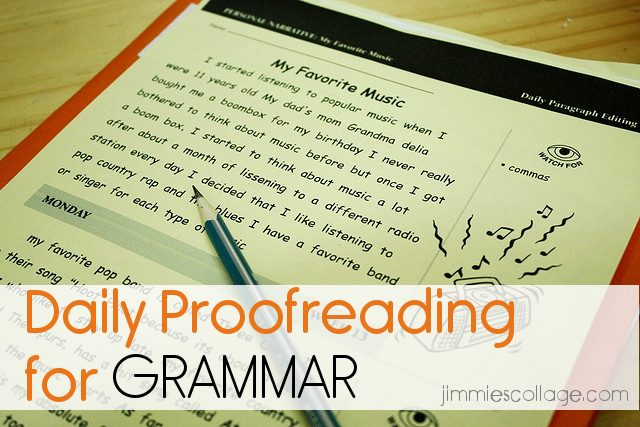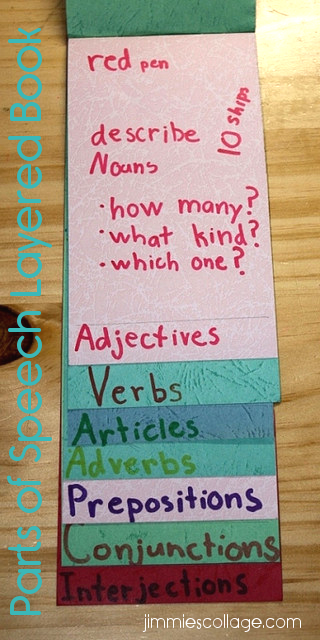
Welcome to the 10 Days of Language Arts series. Today we start it off with grammar plus a dab of usage and mechanics as well.
What is Grammar?
Grammar is the rules of a language. You may think that your child is terrible at grammar, but he probably is quite skilled at it. After all, he can communicate can’t he? Without some understanding of the rules of English, his dialogue would be reduced to gibberish.
How do we Learn Grammar?
When youngsters learn their native tongue, they master the grammar of the language as they listen and through trial and error. (Think of the funny grammar of toddlers as they try out the rules to see what works.) Later, children internalize the rules and use them without any conscious thought. So your children already know a lot of grammar.
What they may struggle with is knowing all the fancy grammatical terms. And they may not know anything about diagramming sentences.
As you begin to map out your teaching of grammar, remember that you are building on a foundation that already exists. When grammar gets tough, remind your children that you are merely teaching them the vocabulary for the rules that they already know how to use.
And be encouraged to know that there really aren’t that many grammar and usage rules that a good writer needs to know.
Why Should We Teach Grammar?
My own opinion is that grammar’s use is very limited. It does have value, but it valuable only to the extent that it is taught in a practical way. In other words, grammar should carry over into real language — written, spoken, and read.
How Should We Teach Grammar?
We Charlotte Mason folks talk a lot about “living” learning: living math, living books, living science. Grammar really should be living too. That is, study grammar in the context of real language rather than in the artificial construct of a grammar book.
Grammar books are wonderful. I have several on my shelves. But use them as reference books instead of as textbooks.
I believe that much of the time spent on grammar worksheets would be better invested in practicing writing. But I do own grammar workbooks and find them very useful at times.
I have chosen to teach grammar mainly in the context of daily proofreading and editing practice. I believe this is a great method for several reasons:
- lessons are short,
- lessons are daily,
- lessons provide opportunity for further grammar study, done in the context of real language,
- and lessons model the skills necessary to edit and revise essays during the writing process.
Charlotte Mason espoused short lessons done regularly. The power of a little done often is truly amazing. When lessons are short, there is little time for boredom, tuning-out, or frustration. But when those short lessons are done every day, there is frequent review which cements the learning. As we all know, most writers struggle with editing their own work. Proofreading and editing practice gives kids practice with that skill that they can carry over into their own work.
When Sprite does a proofreading practice, I take special note of the things she missed. The errors that were overlooked are perfect material for a short grammar lesson. I may take out the grammar reference book and have her read a rule or two. If necessary, she may do some practice of that new grammatical rule, either composing her own sentences or doing exercises in a workbook.
But what if she gets everything right? I take note of that as well and make a mini-lesson from it. I’ll praise her correction and ask her why she made it. If she cannot articulate the reason with the correct grammatical vocabulary, I may teach her the correct terms and the rules that govern the corrections she made.
In this way, our grammar is tied to real language and a real and very practical task — correcting errors.
If you would like to try this method, there are some free pages available at Super Teacher Worksheets and at Education World. Then if you want to invest in a guide, I recommend (affiliate links) Evan Moor’s Daily Paragraph Editing for elementary years and Editor in Chief for middle school and high school.
Copywork for Grammar Lessons
Other Grammar Resources
Besides daily proofreading and editing exercises and copywork, we have used several helpful grammar resources over the years. Here are my top picks:
- Grammar Songs (retail)– silly, sometimes even annoying, songs that help you memorize grammar rules
- Grammarland (free) — a living book (novel) in the public domain in which children go to Grammarland and learn about the parts of speech
- Schoolhouse Grammar Rock (free on YouTube)– fun videos and songs that teach parts of speech
- Parts of Speech Posters (free)– handy for quick reference
Free Curriculum Online
- Scott Foresman Writing Handbooks (free) — PDF lessons and practice pages for grades 1-6
- Holt Elements of Language (free) — an entire student handbook, broken down into individual PDFs; for 9th grade (?)
- Grammar Curriculum from Sinclair Community College (free) — worksheets and handouts for middle school and above
Should Children Learn to Diagram Sentences?
Diagramming is like geometry. You either love it or hate it.
Now we don’t base our homeschool decisions solely on our children’s likes and dislikes. (That would be irresponsible.) But when you know if a child loves or hates diagramming, you have a good clue as to whether or not diagramming will actually be an effective learning tool.
I say that you should not use any teaching technique unless it leads to learning. The same holds true for diagramming.
If your child is visual-spatial or artistic, she may find diagramming really helps her to see the grammar of a sentence. My Sprite is like this, and she grasps a sentence’s grammar more fully after diagramming it.
But if a child is hampered by the diagramming instead of helped, no, it is not necessary.( Read more on my thoughts about diagramming at this article.)
I have two sites to help you with teaching diagramming. So far, these are all I have used with Sprite.
- Commnet’s diagramming examples — an online primer
- Clue Cards for Diagramming Sentences — the PDF linked here is a very thorough guide to diagramming almost every conceivable grammatical structure.
Conclusion
The bottom line for grammar is really application. Can the child use the grammar rules correctly in written compositions (and spoken English)? If so, then his grammar is adequate. Even if he can’t name every type of verbal phrase or list which collective nouns are plural and which are singular, his grammar understanding may very well be sufficient for using those very grammatical elements correctly in a well written essay.
Feel free to leave your questions or suggestions about the teaching of grammar in a comment below. I appreciate your feedback, and I enjoy interacting with you.


I just saw your blog at the Homeschool Blog Awards and decided to come check you out. I am your newest follower and would love for you to follow me back, if you want to =-)
Beth
http://www.livinglifeintentionally.blogspot.com
Thank you for this interesting post about grammar!
Checking out your nifty links now. Love this post, & looking forward to the rest of the series!
My question is this…as your child gets older and starts using the computer, how do you approach the usage of “netspeak”? I’m currently in school to be and educator and I see so many teachers who either allow netspeak in graded classwork, or they’re so worn down that they do not cover proper grammar. This drives me insane! I was in a college Spanish class and breaking down sentences into their diagram helps to figure out the placement in the language, but the professor had to back track and teach grammar to the recent high school graduates. (All of us older folk already knew how to diagram sentences and the correct terminology.)
I perceive “netspeak” as another language, a language that is not appropriate for school work. Students simply have to be held to a different standard when it comes to their schoolwork just as they will be in their jobs.
Great post, Jimmie! Thanks for sharing your wisdom! I look forward to the test of the series!
I am so happy to find all of these post tonight! I am following you now.
I REALLY needed to read this. I’m looking forward to all your “10 Days”! Perfect timing for me.
I’ve just read all of your 10 days posts so far and they are so helpful. I have to say I really AGREE with you on Grammar. We worked ourselves silly with Easy Grammar and it wasn’t that effective (at least for my daughter) — she benefits more from listening in on First Language Lessons with my youngest and we sing grammar songs and talk about grammar as we do copywork, etc… It’s all about REAL LIFE APPLICATION, isn’t it? I feel the same way about math!
Do you have a recommendation for a grammar handbook for middle school age kids? I’ve been reading Ruth Beechick’s book and she recommends that, but I can’t find anything that is the right thing. Thanks!
We use Write Source as our primary language reference. See this post for more info.
I have so enjoyed these 10 days of language arts! It is so easy to just try to “get through” our books, that I fail to take time out to make LA the delight to my children that it was to me growing up…the reenactments of Julius Caesar’s speech on the steps, delving through antique books to find a poem to memorize and share, making neat little lists of writing prompts…thank you for giving us this gourmet smattering of the stuff of which happy LA learners are made! It is pertinent enough that I would {gasp} pay for this in download form–it’s worth the effort of having it all gathered for me and put in one place to refer to. I’ll look forward to it.